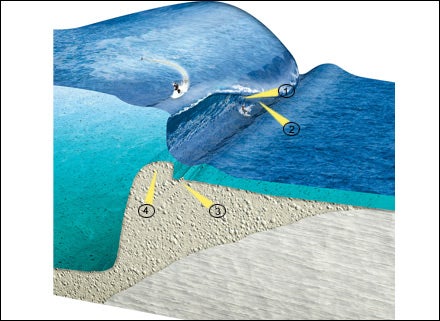IF YOU’VE SEEN PHOTOS or YouTube clips of Tahiti’s Teahupoo surf break, you’ve seen a slab wave. Though Teahupoo might be the best-known slab, surfers are now hunting them down around the world. They can be found in the Pacific Northwest, in Scotland, and, most notably, at Shipstern’s Bluff, in the Southern Ocean off Tasmania: a boiling 50-footer.
Traditional surfing waves roll toward shore, slow down as they rise up, and break cleanly to one or both sides. A slab wave moves fast, through deep water, and hits a shallow reef at full speed. It lifts out of nowhere within seconds, sucks the water out of the shallows in front of it, and then slams shut in a violent thump. The power and danger of a slab come as much from the thickness as the height. For a surfer, riding one of these beasts is like escaping from a collapsing parking garage.
“Short, hollow slabs are some of the most difficult, intricate, and intimidating waves to surf,” says Greg Long, the California-based big-wave phenom who regularly surfs Teahupoo.
Over the past two decades, while traditional big waves like Maverick’s and Jaws hogged the spotlight, slabs were mainly seen as unsurfable freaks. That started to change in 2000, when Laird Hamilton rode a monster at Teahupoo that was at least ten feet thick and 40 feet tall. Now, slabs consistently produce the most dramatic rides of the year.
1. THE TAKEOFF: Slab takeoffs are extremely fast and vertical. A Jet Ski is a must at many slabs.
2. THE HOLE: The trough of the wave hits the reef first, sucking water seaward and into a hole or pit. The wave forms as a backless wallrather than a crestbehind the hole.
3. OBSTACLES: Bumps or cuts in the reef can throw boils into the wave face. On a normal wave, boils are difficult. With the nearly vertical face of a slab, they kick surfers high into the air.
4. SHALLOW REEF: Waves roll out of deep water with all their open-ocean energy intact. That energy gets focused as the depth suddenly decreases.


